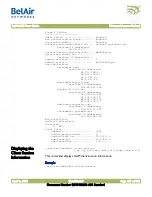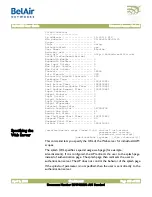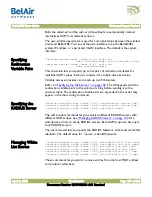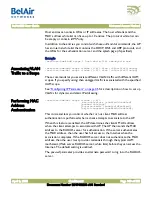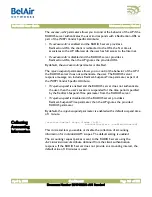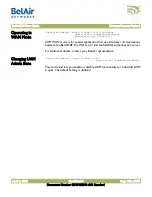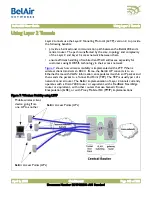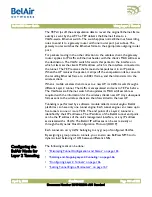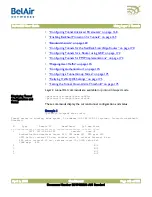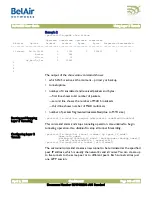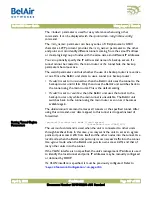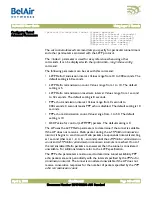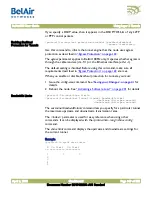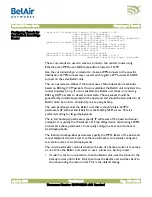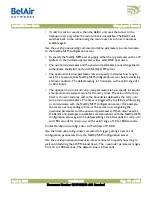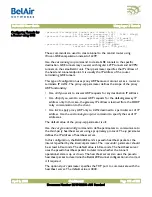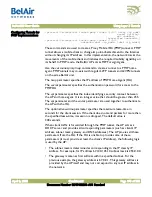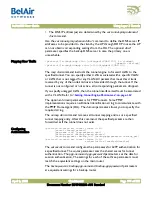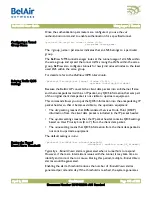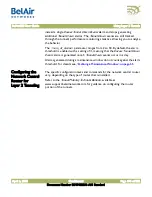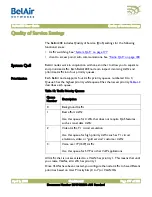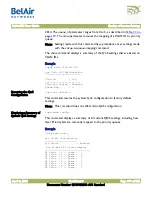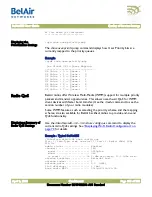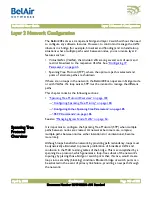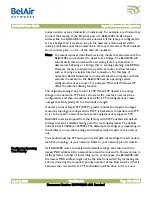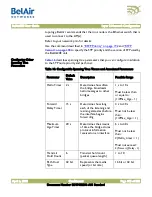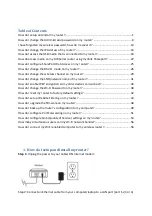
BelAir20E User Guide
Using Layer 2 Tunnels
April 2, 2012
Confidential
Document Number BDTM02201-A01 Standard
Configuring Tunnels for
the RedBack SmartEdge
Router
/protocol/te-<eng>/set tunnel-l2vpn <index (1-5)>
oam {enabled | disabled}
{auto | ip <ip_addr> label <number>
[backup-ip <ip_addr>] [backup-label <number>]}
[switch {non-revertive | revertive}]
/protocol/te-<eng>/set l2vpn autoconfig
{ip <ip_addr> | hostname <host_name>}
username <string> password <string>
[retry-min <sec>] [retry-max <sec>]
[wait-time <min>]
/protocol/te-<eng>/l2vpn autoconfig renew
/protocol/te-<eng>/set tunnel-l2vpn <index (1-5)>
advanced inactivity-timer <seconds>
These commands are used to create a tunnel to the central router using
Ethernet-over-MPLS-over-GRE encapsulation instead of L2TP.
Use the
set tunnel-l2vpn
command to create L2VPN tunnels to the specific
destination. L2VPN tunnels may co-exist with regular L2TP tunnels and GRE
tunnels on the same BelAir unit.
The
oam
parameter defines if the tunnel uses a failure detection mechanism
based on 802.1ag CCM packets. If
oam
is disabled, the BelAir unit considers the
tunnel to always be up. If
oam
is enabled, the BelAir unit relies on receiving
802.1ag CCM packets to detect tunnel state. These packets should be
generated by outside equipment in the head end and should be forwarded to all
BelAir units. Set
oam
to
enabled
if you are using backup.
The
auto
parameter tells the BelAir unit that it should obtain L2VPN
parameters (IP address and label) from the NetOp NSM server. This is a
preferred setting for large deployments.
The
ip
and
backup-ip
parameters specify IP addresses of the head end tunnel
endpoint. It is usually the IP address of a SmartEdge device terminating L2VPN
tunnels. Use these parameters to manually configure a test environment or
small deployments.
The
label
and
backup-label
parameters specify the MPLS labels of the head end
tunnel endpoint virtual circuit. Use these parameters to manually configure a
test environment or small deployments.
The
switch
parameter controls whether the use of a backup router is revertive
or not. Once the BelAir unit starts to use a tunnel to a backup router:
• If
switch
is set to
non-revertive
, then the BelAir unit uses the tunnel to the
backup router until it fails. Only then does the BelAir unit switches back to
the tunnel using the main router. This is the default setting.


